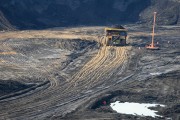Building and running a comprehensive monitoring program for the oilsands that keeps pace with the rapid growth of the industry is very challenging — especially considering how huge the industry is already. Oilsands development currently produces 61 million tonnes of greenhouse gas pollution, consumes 185 billion litres of freshwater annually and has directly transformed more land area than the entire city of Calgary.
It’s been a busy week for oilsands monitoring: the Federal Commissioner of the Environment and Sustainable Development delivered the findings of its audit of the Joint Canada-Alberta Oilsands Monitoring (JOSM) program, the Alberta Auditor General published its review of provincial responsibilities under this plan and the JOSM annual progress report for 2013-14 was also released.
These reports acknowledge the substantial effort undertaken to redesign, harmonize and streamline environmental monitoring in the oilsands. Bringing all environmental monitoring activities over a region that covers 21 per cent of Alberta under one roof is an enormous and commendable endeavour.
However, key questions that underpin the overall effectiveness of this environmental monitoring system have yet to be answered or fully addressed in any of these reports. Addressing these persistent issues will be critical in ensuring the entire system is developed in a credible and effective manner.
An arbitrary limit to funding
At the onset of the JOSM program, total funding for all environmental monitoring was capped at $50 million annually. In the federal report, Environment Canada told the Environment Commissioner that this amount represents a $35 million increase from previous annual funding. It’s unclear, however, what year and programs were considered by Environment Canada in determining “previous annual funding”. Looking at historic funding alone doesn’t reflect the reality of continued industrial expansion, nor the gaps or issues identified in past monitoring activities. Unfortunately, no further justification was provided for the decision to limit funding for monitoring.
Cost effectiveness is important, but there must be a scientific rationale for the level of funding chosen. An arbitrary limit of $50 million doesn’t reflect the expansion of environmental monitoring that’s necessary in a region that saw industrial investment of over $30 billion last year.
Expected investment into the oilsands until 2035 is estimated at $364.1 billion. At $50 million annually, environmental monitoring only represents 0.3 per cent of that investment over the same time period. Establishing a comprehensive monitoring system requires greater upfront investment.
A lack of stakeholder input
Highlighted in the Environment Commissioner’s report is the continued lack of First Nation involvement in the monitoring process. A number of First Nations withdrew from the process in late 2013, citing no meaningful inclusion of First Nation treaty rights, traditional knowledge, or expertise.
There’s also ongoing confusion at established monitoring agencies regarding community engagement activities. The Alberta Government has indicated that stakeholder relations are to be coordinated by the new provincial monitoring agency AEMERA (Alberta Environmental Monitoring Evaluation and Reporting Agency), but have yet to demonstrate how this will occur. The established monitoring agencies remain in the dark about how or if their practices fit within the new reality of provincially centralized environmental monitoring.
At this point, stakeholders are unable to determine how their feedback is incorporated into monitoring programs. In June 2014, both levels of government had undertaken a two-day multi-stakeholder session to gather stakeholder input, but how that feedback will be incorporated into final monitoring decisions remains unknown. What is clear is that there’s a continued need for local input. After all, it’s local communities that must live with the impacts being monitored.
Decision-making based on flawed, inaccurate or incomplete data
Information gained from monitoring is most effective when it can inform decisions pertaining to the cumulative environmental impacts of oilsands development. The improvements needed in oilsands environmental monitoring had been investigated over four years ago and the commitment to redesign the system was made over two years ago. What’s concerning is, despite both levels of government recognizing the need for improvements and committing to enhancements, oilsands projects continue to be approved. In other words, development decisions continue to be based on flawed, inaccurate or incomplete data. With each new oilsands project approved based on incomplete information, Albertans take on more environmental liability.
None of these issues are new; these questions have been raised during every step of the redevelopment process. What’s most telling is the lack of leadership to address these critical questions. This leadership vacuum is made even more evident with an ongoing “changing of the guard” for management of the redesign. Over the past year of my involvement, I have already seen three different provincial appointments to lead the endeavour. Most recently, a new CEO of AEMERA was announced last week. These changes have created so much confusion, that it’s unclear where oilsands environmental monitoring is heading. And to be honest, it’s getting hard to tell whether the glass is half-full or half-empty.










